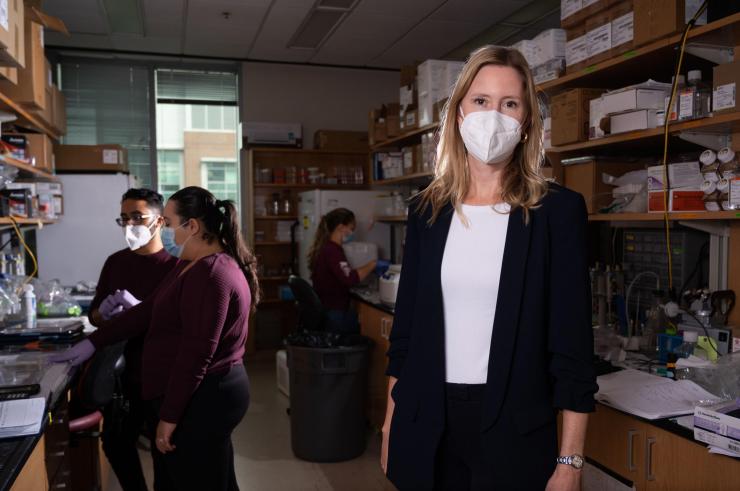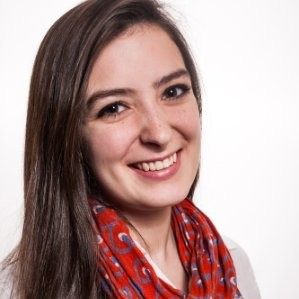Scaffolding Tumor Formation Sets the Stage for Better Immunotherapies
Mar 01, 2022 — Atlanta, GA

Susan N. Thomas, Woodruff Professor and associate professor of mechanical engineering
The discrepancy between preclinical advances in breast cancer immunotherapy and poor patient outcomes is rooted in the limitations of current breast cancer models. These models often fail to mimic complex interactions between cancer cells and key immune cells present in the tumor microenvironment.
Utilizing a collaborative approach, Susan N. Thomas, associate professor in the George W. Woodruff School of Mechanical Engineering at the Georgia Institute of Technology, and former doctoral student Meghan O’Melia developed a novel way to generate breast tumor models faster, more reliably, and with dramatically less immune variability than existing models. Their innovative research, published in the January issue of Advanced Materials, has the potential to revolutionize the development of immunotherapy treatments and can also help elucidate why patients with the same type of breast cancer respond differently to treatment.
By using a gel-like matrix as a scaffold to grow breast cancer tumors, Thomas and O’Melia were able to modulate how immune cells filter into a tumor’s microenvironment. In doing so, they created tumor models exceptionally well-suited to immunotherapy drug testing. Moreover, by tweaking the scaffold, they were able to replicate immune microenvironments seen in treatment-resistant breast cancer patients.
“This work provides us with new models to understand how tumor microenvironments influence responses to immunotherapies,” said O’Melia, now a postdoctoral fellow at Harvard. “We see potential for predicting, based on the immune characteristics of a patient’s tumor, what therapy that person will best respond to.”
Limitations of Breast Cancer Models
Current advanced breast cancer models have key drawbacks. One type of model involves injecting human tumor cells into mice that lack a complete immune system, but this complicates the study of immune-targeting therapies. In a different approach, mice are manipulated at the genome level to make them cancer prone. Although their immune responses may closely resemble that of human patients, the rate of tumor development is highly variable, making these models suboptimal for scalable drug testing.
The most common way to generate breast cancer models for immunotherapy research, however, is by injecting mouse breast cancer cells directly into healthy mice. This method is affordable and scalable, but sometimes up to 80% of mice in an experiment will not grow tumors.
To address this, breast cancer researchers began to inject the tumor cells alongside a commercially sold gelatinous protein mixture derived from mouse cells (Matrigel), which helps tumors grow reliably. The problem with the mixture, however, is that its composition varies from batch to batch. Using the mixture therefore creates more unknown variables, affecting a mouse’s immune response in unpredictable ways.
An unexpected solution presented itself when Thomas and O’Melia attended a regenerative medicine workshop. At the workshop, Edward Botchwey, associate professor in the Walter H. Coulter Department of Biomedical Engineering, introduced a bioengineered scaffold able to modulate how immune cells filtrate into a wound site to facilitate tissue healing.
“I turned to Meghan and said, ‘Why don’t we see if they want to collaborate to explore if we can change how immune cells are recruited to the site where we are implanting our tumors?’” Thomas said.
They set out to work with Botchwey and Andrés García, professor of mechanical engineering and executive director of the Parker H. Petit Institute for Bioengineering and Bioscience (IBB), to develop a scaffold to grow breast tumors.
A Novel Scaffold to Shape the Tumor Microenvironment
The team developed their own synthetic jelly-like matrix. They then injected triple negative breast cancer (TNBC) cells, the most aggressive type of breast cancer, alongside the matrix as a scaffold to help them grow. They found that their breast cancer tumors formed at a rate of 100% and did so faster and with lower variability in growth than when using Matrigel. Most importantly, their scaffold limited the type of immune cells that infiltrated into the tumor microenvironment. Their approach resulted in the kind of controlled environment ideal for experiments in immunotherapy drug testing.
Taking a step further, the team created different formulations of the gel matrix by incorporating biomolecular tags readily recognized by immune cells. The tags are made of peptides and serve to recruit key immune cells to the microenvironment. Incorporating the tags enabled Thomas and O’Melia to model different subtypes of immune environments often seen in treatment-resistant TNBC.
They then tested two of the most common types of immunotherapy drugs — vaccines and immune checkpoint blockade therapy — on the different subsets of cancer microenvironments.
“When we used different matrix components, we saw different effects of these drugs on the same type of cancer,” Thomas said. “There is a lot of variability related to why some patients respond to therapy or not, and until now there was no way to incorporate that into our mouse models when developing drugs.”
Looking Beyond the Lab
The findings demonstrate the essential role a patient’s tumor immune microenvironment plays in the success of immunotherapies, stressing the importance of their new approach for future drug testing.
Thomas and O’Melia’s work carries broad potential for pre-screening immunotherapy drugs for individual patients. Hypothetically, for the average cancer patient, a clinician could do a simple biopsy, determine what immune cells are present, and choose a better therapy.
They also collaborated with Levi Wood, assistant professor of mechanical engineering, and investigators at IBB who contributed immune phenotyping for the experiments.
“Basically, by using an established technology but applied in a new way, we created a new tool to solve an old problem,” Thomas said. “The collaborative nature of this project was spectacular, and that is really intrinsic to the Georgia Tech community.”
***
Susan N. Thomas is an associate professor in the George W. Woodruff School of Mechanical Engineering and Woodruff Professor in the College of Engineering.
Edward Botchwey is an associate professor in the Walter H. Coulter Department of Biomedical Engineering.
Andrés J. García is executive director of IBB, the Petit Director's Chair in Bioengineering and Bioscience, and Regents' Professor in the George W. Woodruff School of Mechanical Engineering.
Levi Wood is an assistant professor in the George W. Woodruff School of Mechanical Engineering.
CITATION: Meghan J. O'Melia, Adriana Mulero-Russe, Jihoon Kim, Alyssa Pybus, Deborah DeRyckere, Levi Wood, Douglas K. Graham, Edward Botchwey, Andrés J. García, and Susan N. Thomas, “Synthetic matrix scaffolds engineer the in vivo tumor immune microenvironment for immunotherapy screening,” Advanced Materials (Jan. 6, 2022).
DOI: https://doi.org/10.1002/adma.202108084
FUNDING: U.S. National Institutes of Health grants: R01CA207619 (SNT), U01CA214354 (SNT), R01AR062920 (AJG), R01AR062368 (AJG), S10OD016264 (AJG), T32GM008433 (MJO), and T32EB006343 (AMR)
Writer: Catherine Barzler
Media Contact: Catherine Barzler | catherine.barzler@gatech.edu

Susan N. Thomas in her lab

Meghan O'Melia, postdoctoral fellow at Harvard and former Georgia Tech Ph.D. student
Catherine Barzler





